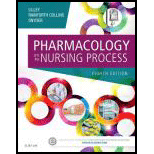
To compare:
Briefly discuss the normal anatomy and physiology of the autonomic nervous system, including the events that take place within the sympathetic and parasympathetic divisions as related to long-term and short-term control of blood pressure.
Concept introduction:
The autonomic nervous system is a part of the nervous system that is responsible for controlling the body functions such as heartbeat, digestive process, and breathing process. The sympathetic nervous system is responsible for the fight or flight response and the parasympathetic nervous system is responsible for the feed and breed system.
Explanation of Solution
The autonomic nervous system is classified into two divisions, namely the sympathetic nervous system, and the parasympathetic nervous system. The ANS is stimulated by the neurotransmitters such as norepinephrine and acetylcholine. The ANS receptors are located throughout all parts of the body tissues. Receptors are present between the effector cells and postganglionic fiber are called as cholinergic or muscarinic receptors in the parasympathetic system.
The cholinergic or acetylcholine agonist drugs stimulate the muscarinic receptors and its activity is inhibited by the cholinergic antagonists. The norepinephrine, adrenergic agonists and epinephrine stimulate the physiologic activity of adrenergic receptors and its activity is inhibited by the antiadrenergic such as α and β blockers.
The most of the adrenergic drugs are used to dilate the arteries to reduce hypertension.
The short-term regulation of blood pressure increases the blood pressure which in turn stimulates the parasympathetic system. The parasympathetic nervous system reduced the vasodilation, heart rate, and lower the blood pressure. The Long-term regulation of blood pressure stimulates the aldosterone mechanism and renin-angiotensin mechanism.
The location of the autonomic nervous system and its function related to blood pressure regulation.
Want to see more full solutions like this?
Chapter 22 Solutions
Pharmacology and the Nursing Process, 8e
- true or false dark skinned infants should be screened for vitamin D levelsarrow_forwardtrue or false any practice employee is authorized to and should communicate collection guidelines with practice?arrow_forwardrtrue or false equesting a listing of specific creditreferences during patient intake os an acceptable business practice?arrow_forward
- give an overview on the respiratory assessmentarrow_forwardexplain an abdominal exam?arrow_forwardDiscuss β -Lactam antibiotics under the following subheadings Classifications of penicillins Classification of Cephalosporins General Mechanism of Actions Clinical Indications of penicillins and cephalosporins Adverse effects of β-lactamsarrow_forward
- a. Define neoplasm b. Differentiate between benign and malignant tumours c. Describe the molecular basis of cancerarrow_forwarddifferentiate the extra heart sounds S3,S4, murmurs and gallopsarrow_forward• Define shock and list types of shock • Discuss pathogenesis of septic shock. • Enumerate the stages of shock. • Define oedema and describe the pathophysiologic mechanisms of oedema with examples.arrow_forward
- Discuss Hypertension under the following headings: Definition Diagnosis Non-pharmacological intervention Drugs Classification Management of a Hypertensive emergencyarrow_forwardExplain how the answer could be 2 or 1.8 WITHOUT changing the questionarrow_forwardoverview of the neurological system, cranial nerves and what part of the body it innervatesarrow_forward
 Phlebotomy EssentialsNursingISBN:9781451194524Author:Ruth McCall, Cathee M. Tankersley MT(ASCP)Publisher:JONES+BARTLETT PUBLISHERS, INC.
Phlebotomy EssentialsNursingISBN:9781451194524Author:Ruth McCall, Cathee M. Tankersley MT(ASCP)Publisher:JONES+BARTLETT PUBLISHERS, INC. Gould's Pathophysiology for the Health Profession...NursingISBN:9780323414425Author:Robert J Hubert BSPublisher:Saunders
Gould's Pathophysiology for the Health Profession...NursingISBN:9780323414425Author:Robert J Hubert BSPublisher:Saunders Fundamentals Of NursingNursingISBN:9781496362179Author:Taylor, Carol (carol R.), LYNN, Pamela (pamela Barbara), Bartlett, Jennifer L.Publisher:Wolters Kluwer,
Fundamentals Of NursingNursingISBN:9781496362179Author:Taylor, Carol (carol R.), LYNN, Pamela (pamela Barbara), Bartlett, Jennifer L.Publisher:Wolters Kluwer, Fundamentals of Nursing, 9eNursingISBN:9780323327404Author:Patricia A. Potter RN MSN PhD FAAN, Anne Griffin Perry RN EdD FAAN, Patricia Stockert RN BSN MS PhD, Amy Hall RN BSN MS PhD CNEPublisher:Elsevier Science
Fundamentals of Nursing, 9eNursingISBN:9780323327404Author:Patricia A. Potter RN MSN PhD FAAN, Anne Griffin Perry RN EdD FAAN, Patricia Stockert RN BSN MS PhD, Amy Hall RN BSN MS PhD CNEPublisher:Elsevier Science Study Guide for Gould's Pathophysiology for the H...NursingISBN:9780323414142Author:Hubert BS, Robert J; VanMeter PhD, Karin C.Publisher:Saunders
Study Guide for Gould's Pathophysiology for the H...NursingISBN:9780323414142Author:Hubert BS, Robert J; VanMeter PhD, Karin C.Publisher:Saunders Issues and Ethics in the Helping Professions (Min...NursingISBN:9781337406291Author:Gerald Corey, Marianne Schneider Corey, Cindy CoreyPublisher:Cengage Learning
Issues and Ethics in the Helping Professions (Min...NursingISBN:9781337406291Author:Gerald Corey, Marianne Schneider Corey, Cindy CoreyPublisher:Cengage Learning





